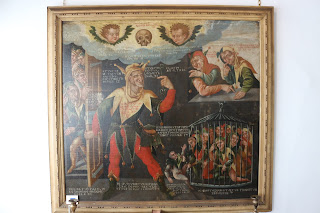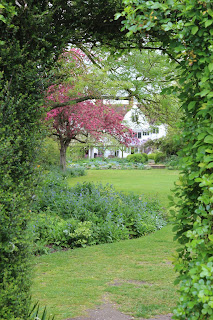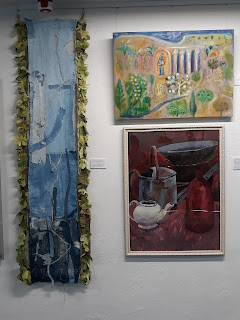Paycocke's House and Gardens is a stunning Tudor merchant's house in Coggeshall. Visiting Paycocke's and Thaxted forms a mini Conrad Noel pilgrimage.
In 1904 Paycocke’s was bought by Lord Noel Buxton, a direct descendant of the previous Buxton owners, who oversaw the restoration making the house as one again and returning it to what he believed was its original state.
This was an ambitious task that took 20 years to complete and during the restoration, Noel Buxton’s cousin Conrad Noel and his wife Miriam lived in the building rent free. Noel was born in Kew and as a boy was "incarcerated in two public schools", as he later wrote. He went as a student to Cambridge but only stayed for one year in which time he acquired the Socialist beliefs that shaped the whole of his subsequent career. His early career was chequered; he was initially refused ordination because of his political beliefs and in 1906, with Reverend Percy Widdrington and others, formed the Church Socialist League.
A major event in Noel's life for which he is well-remembered was the "Battle of the Flags". As he later wrote, in Thaxted "we date everything from before or after the Battle of the Flags". Towards the end of the First World War he displayed in Thaxted Church the Sinn Fein flag, the Red Flag and the flag of St George, each of which was provocative and anti-establishment. Noel looked upon the Union Jack as the emblem of Britain’s "cruel exploitation" of the peoples of its Empire. With the rise of post-war Irish and labour troubles feelings polarised, and in 1921 a "battle" broke out, bringing Thaxted and its "Red Vicar" national notoriety. Cambridge students journeyed to Thaxted and ceremoniously pulled down the flags. Fighting broke out inside the Church and there were other disturbances. Questions were asked in Parliament and Noel was accused of sedition. Eventually, a Church of England consistory court was convened and Noel complied with its order to remove the flags.
Noel was a man of enormous charisma, energy and talent, all of which he brought to bear in making Thaxted a centre of religious, political and cultural activity, the last in particular for the English Arts and Crafts movement. His insistence that Christianity was about beauty and ritual attracted well-known artists and musicians to Thaxted, which became a place where folk traditions were encouraged. Noel was a strong influence on Gustav Holst during the years that the composer lived in Thaxted.
In 1923 Holst spent a summer at Paycocke’s House with his family. Having suffered a personal injury, Gustav saw Paycocke’s as the perfect retreat to recuperate in the country. His daughter, 16-year-old Imogen, spoke of her stay in letters to her school friend: 'This house is absolutely too wonderful for words...it is a dream. And it is great fun living in a dream...The house is supped to be the best example of the period in the whole of England, and artists and architects make pilgrimages from all over the country to see it. We are tremendously proud of it, and as it isn’t our own we can swank about it to our heart’s content.'
Under the influence of Noel and his wife Miriam, musical festivals, folkloric gatherings, maypole and Morris dancing all became part of local life. The Noels were experts in these traditions and encouraged everyone to be part of these activities. A folk revival was happening across Europe in the 1920s and 1930s, and the Morris Ring, the national organisation, was founded at a meeting in the town in 1934. English Morris Dancing still sees Thaxted as its home and the town boasts the country's oldest continuous existing 'side'.
This was an ambitious task that took 20 years to complete and during the restoration, Noel Buxton’s cousin Conrad Noel and his wife Miriam lived in the building rent free. Noel was born in Kew and as a boy was "incarcerated in two public schools", as he later wrote. He went as a student to Cambridge but only stayed for one year in which time he acquired the Socialist beliefs that shaped the whole of his subsequent career. His early career was chequered; he was initially refused ordination because of his political beliefs and in 1906, with Reverend Percy Widdrington and others, formed the Church Socialist League.
Noel described living on a building site yet being enthralled by the new discoveries that were continually being made: "We lived in an atmosphere of dust and white-wash and broken plaster." Miriam was an extremely keen gardener and whiled away many hours in the little garden which stretched down to the river. Inspired by the contemporary Arts & Crafts movement, she set out the entire garden in that style, installing a central path, a circular feature, stepped terraces, a writing shelter and a dovecote. The site even included a tennis court.
By 1910 the main restoration work on the house had been completed and that year Noel was appointed by the Countess of Warwick to the living of Thaxted, remaining its vicar until his death in 1942. In this rather remote corner of Essex, Noel preached his own version of Socialism and the Anglo-Catholic gospel. He brought life and controversy to the town though his outspoken political views and his enthusiastic encouragement of music and traditional rural customs.
Despite his patron's hope that he would use Thaxted as a base from which to propagate their shared socialist beliefs to a countrywide audience, Noel remained stubbornly faithful to and diligent in his work for the people of his parish, refusing her wishes that he should preach the gospel at large by "careering up and down the country giving Socialist lectures" as he later described it. In 1911 he was a founding member of the British Socialist Party but left it in 1918 to found the Catholic Crusade. He was also a member of the Independent Labour Party. But, for Noel, the parish was always the focal point of the priest's work, though his Catholic Crusade did carry his ideas to a wider public.
By 1910 the main restoration work on the house had been completed and that year Noel was appointed by the Countess of Warwick to the living of Thaxted, remaining its vicar until his death in 1942. In this rather remote corner of Essex, Noel preached his own version of Socialism and the Anglo-Catholic gospel. He brought life and controversy to the town though his outspoken political views and his enthusiastic encouragement of music and traditional rural customs.
Despite his patron's hope that he would use Thaxted as a base from which to propagate their shared socialist beliefs to a countrywide audience, Noel remained stubbornly faithful to and diligent in his work for the people of his parish, refusing her wishes that he should preach the gospel at large by "careering up and down the country giving Socialist lectures" as he later described it. In 1911 he was a founding member of the British Socialist Party but left it in 1918 to found the Catholic Crusade. He was also a member of the Independent Labour Party. But, for Noel, the parish was always the focal point of the priest's work, though his Catholic Crusade did carry his ideas to a wider public.
A major event in Noel's life for which he is well-remembered was the "Battle of the Flags". As he later wrote, in Thaxted "we date everything from before or after the Battle of the Flags". Towards the end of the First World War he displayed in Thaxted Church the Sinn Fein flag, the Red Flag and the flag of St George, each of which was provocative and anti-establishment. Noel looked upon the Union Jack as the emblem of Britain’s "cruel exploitation" of the peoples of its Empire. With the rise of post-war Irish and labour troubles feelings polarised, and in 1921 a "battle" broke out, bringing Thaxted and its "Red Vicar" national notoriety. Cambridge students journeyed to Thaxted and ceremoniously pulled down the flags. Fighting broke out inside the Church and there were other disturbances. Questions were asked in Parliament and Noel was accused of sedition. Eventually, a Church of England consistory court was convened and Noel complied with its order to remove the flags.
Noel was a man of enormous charisma, energy and talent, all of which he brought to bear in making Thaxted a centre of religious, political and cultural activity, the last in particular for the English Arts and Crafts movement. His insistence that Christianity was about beauty and ritual attracted well-known artists and musicians to Thaxted, which became a place where folk traditions were encouraged. Noel was a strong influence on Gustav Holst during the years that the composer lived in Thaxted.
In 1923 Holst spent a summer at Paycocke’s House with his family. Having suffered a personal injury, Gustav saw Paycocke’s as the perfect retreat to recuperate in the country. His daughter, 16-year-old Imogen, spoke of her stay in letters to her school friend: 'This house is absolutely too wonderful for words...it is a dream. And it is great fun living in a dream...The house is supped to be the best example of the period in the whole of England, and artists and architects make pilgrimages from all over the country to see it. We are tremendously proud of it, and as it isn’t our own we can swank about it to our heart’s content.'
Under the influence of Noel and his wife Miriam, musical festivals, folkloric gatherings, maypole and Morris dancing all became part of local life. The Noels were experts in these traditions and encouraged everyone to be part of these activities. A folk revival was happening across Europe in the 1920s and 1930s, and the Morris Ring, the national organisation, was founded at a meeting in the town in 1934. English Morris Dancing still sees Thaxted as its home and the town boasts the country's oldest continuous existing 'side'.
Noel loved the medieval poem ‘The General Dance’, also known as ‘Tomorrow Shall be my Dancing Day’,
and sometimes read it from the pulpit instead of giving a sermon. The poem describes the ministry of Christ as a dance, to which will
call his ‘true love’, Christian believers who will dance with him in joy. Holst composed a new setting for Noel, dedicated to him as a birthday gift.
A version of The General Dance can be found in the church in coloured manuscript, framed in carved wood. It hangs over the chest by the
entrance door. This chest was carved by Arthur Brown, with
panels, beginning with the preaching of the Gospel from
Thaxted pulpit, resulting in the treading down of dynasties
and crowns; the hammer and sickle adorn the third panel, the
symbol of artisans and labourers coming into their own, and
the fourth panel represents the music of the spheres, which
will be the music of the Kingdom of Heaven here on earth. On this hutch rest the delicately shaped “Praying Hands” by Eric Kennington, flanked by two shapely candles in black.
When Noel died in July 1942, he was buried in the churchyard, close to the high altar inside the church. Inside, he is remembered by a bronze head in the crossing, facing the high altar. His tombstone carries the words "He loved justice and hated oppression".
When Noel died in July 1942, he was buried in the churchyard, close to the high altar inside the church. Inside, he is remembered by a bronze head in the crossing, facing the high altar. His tombstone carries the words "He loved justice and hated oppression".
Noel's legacy continues with Thaxted Morris and the Thaxted Festival. In 1951 his legacy also led to Thaxted being part of the fortnight-long Three Villages Festival for the Festival of Britain. The Essex Rural Community Council chose the three Festival villages in Essex with care. Great Bardfield had been an artists’ colony since Eric Ravilious and Edward Bawden fell on it in the early 1930s; Finchingfield, with its archetypal village green, was full of ‘theatrical settlers’ such as Val Gielgud (and Dodie Smith); Thaxted prided itself on its musical life, since Holst had lived there and Noel held concerts in his luminous, lofty medieval wool church.
Today Thaxted Church has a thickly textured monochrome moon portrait by Stanley Clifford-Smith who painted many religious works and was greatly influenced by the French expressionist Georges Rouault. Clifford-Smith was an active member of the Great Bardfield Artists community during the mid to late 1950s and became the Honorary Secretary of the group.
Today Thaxted Church has a thickly textured monochrome moon portrait by Stanley Clifford-Smith who painted many religious works and was greatly influenced by the French expressionist Georges Rouault. Clifford-Smith was an active member of the Great Bardfield Artists community during the mid to late 1950s and became the Honorary Secretary of the group.
-------------------------------------------------------------------------------------------------
Gustav Holst - Thaxted.

















































